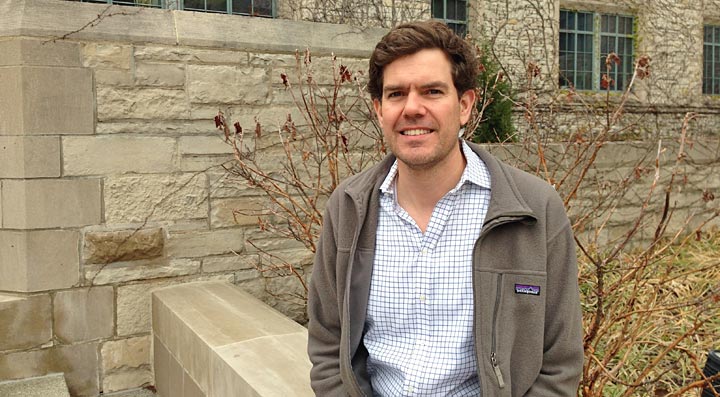NSLS User Profiles: Steve Jacobsen, Northwestern University and COMPRES
July 28, 2014
This is part of a series of profiles on users at the National Synchrotron Light Source (NSLS). First operated in 1982, NSLS has accommodated more than 18,400 unique users in its lifetime as a Department of Energy user facility (see NSLS user stats). After 32 years of distinguished operations, NSLS will shut down on September 30, 2014. Replacing it is NSLS-II, which has been under construction since 2009 and is on track for early completion. When fully built out, NSLS-II will accommodate 60-70 beamlines and host over 4,000 users every year.
Northwestern University is a member of COMPRES, which has had a long-standing relationship at NSLS. How has this benefitted your research?
The high-pressure infrared (IR) beamline U2A is supported by COMPRES (Consortium for Materials Properties Research in Earth Sciences) under the National Science Foundation Cooperative Agreement EAR 11-57758 and by the Department of Energy-National Nuclear Security Administration DE-FC-52-O8NA28554 through the Carnegie/DOE Alliance Center. I am both a geophysicist and materials scientist investigating the properties of materials at extreme conditions of pressure and temperature. High-pressure science applies to understanding Earth’s dynamic interior, material equations of state, and synthesis of novel materials.
Although my lab at Northwestern is only 45 minutes away from the Advanced Photon Source at Argonne National Laboratory, my graduate students and I have regularly come to NSLS for its brilliant synchrotron-IR light on the VUV ring. At beamline U2A, we are able to study the IR absorption and reflectivity of materials under extreme conditions through diamond-anvil cells. The synchrotron-IR techniques available at beamline U2A provide us with a unique combination of broad spectrum, high flux and spatial resolution that we could never achieve on our home-lab IR spectrometer.
Compressed between large diamond anvils to pressures in excess of 100 GPa (a measure of pressure, roughly equivalent to 3000 km depth in the Earth), some of our samples measure only a few micrometers thick. One of the things we are working on is reacting silicate minerals with water at conditions of the deep mantle. At NSLS, we have learned that several high-pressure mantle minerals, stable in the Earth at a depth ranging from about 400 to 600 km, can incorporate significant amounts of water in the form of OH (hydroxyl). These minerals, such as ringwoodite, may act as the largest geochemical reservoir of water on the Earth, with implications for the origin of Earth’s water. When such minerals are taken to conditions a little deeper than 600 km, they break down in a process called dehydration melting, which we have been able to investigate at NSLS beamline U2A. Such dehydration melting has also been detected in the Earth’s mantle using seismic waves, and our most recent study on the Earth’s deep water cycle, published in Science (June 13, 2014), was picked up by a lot of press, including The New York Times and The Guardian.
In the area of new materials, we are working on creating new compounds that rival diamond in properties such as hardness and thermal stability. Some of these so-called superhard materials are created by substituting boron and nitrogen for carbon in the diamond structure, and we are using synchrotron-IR to study the defect substitution mechanisms.
What will you do when NSLS shuts down?
Certain aspects of our projects will be on hold, but hopefully not for too long. The high-pressure IR facility on U2A at NSLS is unique in the world. One of my students has begun to carry out more theoretical calculations, which he will use to help us interpret our experimental data on water (and other volatiles) in extreme environments. But eventually research groups like mine will need a beamline like U2A for direct measurements and discovery science. During the shutdown we will have the opportunity to do a lot of manuscript writing and planning proposals for our future research.
Do you plan to use NSLS-II? Why?
The U2A IR facility at NSLS has been a critical research facility for my group, but also for colleagues from around the world spanning applications in mineralogy and geochemistry, geophysics, high-pressure physics, physical chemistry, and materials science. I have been involved in the planning and proposal process for the new Frontier Synchrotron Infrared Spectroscopy (FIS) Beamline under Extreme Conditions, which has been approved as one of the eight NxtGen beamlines to be developed and constructed at NSLS-II. Zhenxian Liu and Russell Hemley (Carnegie Institution of Washington) and FIS team members like me have been working closely with Brookhaven Lab’s Photon Sciences staff to move forward with the development of FIS. A beamline execution plan detailing the FIS project is in the advanced draft stage. I hope the FIS plan will move forward so that we can use NSLS-II for future synchrotron-IR studies of novel materials and geophysical processes.
2014-5084 | INT/EXT | Newsroom










